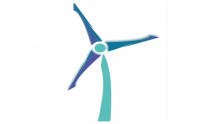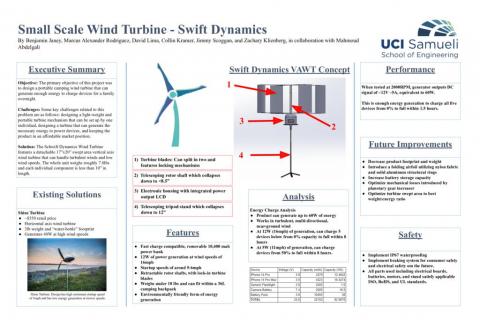Small Scale Wind Turbine
Background
With the world becoming incentivized to use more renewable and sustainable energy sources, portable energy storage such as power banks, batteries, and generators do not fit the fossil fuel-free standard. Small Scale Wind Turbine is a project to design and establish a manufacturing plan for a portable wind turbine for consumer camping use in casual or emergency situations.
Our Small Scale Wind Turbine aims to utilize air and wind as natural resources to convert that energy into powering devices such as cellphones, electric stoves, or flashlights. Our turbine is designed so that even minimal wind speeds will be able to provide power. Taking advantage of natural resources, this will be reducing the overall negative effects on the surrounding environment thus cutting down on the use of fossil fuels.
Goals and Objectives
Our team's goal for this project is to produce and provide realistic and practical concepts involving portable wind turbines. We aim to match or exceed currently available portable wind turbine designs that are on the market. To reach this standard, our turbine must be able to store enough energy to power devices on a single overnight charge and the design will be lightweight and inexpensive and will be easily assemblable requiring at most 2 people.
- Weeks 1-2: Team Organization and Concept Generation
- Weeks 3-4: Finalizing Key DesignConcepts (wind blade design, vertical or horizontal, targeted location, targeted power generation)
- Weeks 5-6: Prototype Solid Modeling and Circuit Design
- Week 7: Final Design and Creating Bill of Materials
- Weeks 8-10: Establishing Manufacturing Process
Key Design Element
Unlike our project logo, the team has decided on going with a vertical-axis wind turbine rather than the well-known commercial horizontal-axis wind turbines. While vertical turbines may generate less power than horizontal turbines our design is aimed to charge camping devices rather than household items meaning that less efficiency is acceptable. Another reason we went with a vertical-axis wind turbine is that compared to horizontal turbines, a vertical turbine is more efficient in turbulent wind areas without constant wind streams and because our design is meant to be portable it is more reasonable to assume turbulent wind conditions for the average consumer.
Link to Contacts
Benjamin Janey (bjaney@uci.edu)
Collin Kramer (cjkramer@uci.edu)
David Lima (josedr3@uci.edu)
Jimmy Scoggan (jscoggan@uci.edu)
Marcus Rodriguez (marcusr2@uci.edu)
Zachary Kleinbergs (zkleinbe@uci.edu)
Advisor
Mahmoud Abdelgalil (maabdelg@uci.edu)
https://docs.google.com/presentation/d/1iy9j_NyIkgEzc14K5q2EdlBC6WAI1zmi8XNT214JNS4/edit


